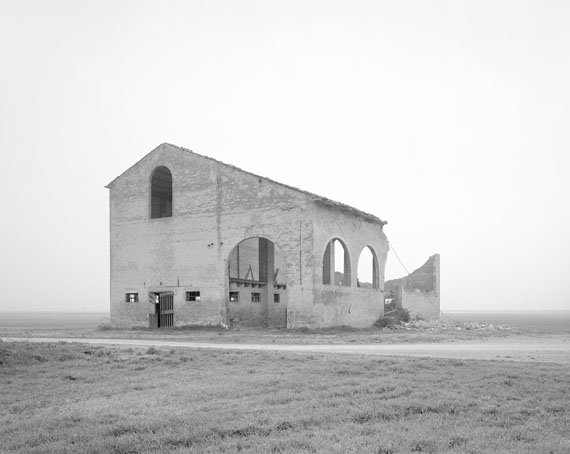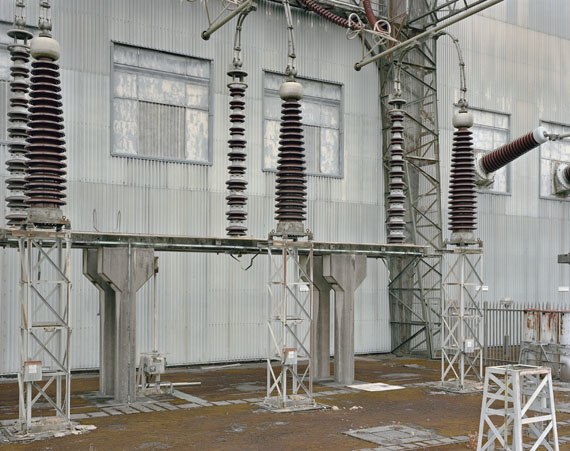
© Paola De Pietri
Tracing Transformations – Photographic Impressions between Landscape and Living Environment
Witterungen – Photographische Aufzeichnungen zwischen Landschaft und Lebenswelt
Laurenz Berges » Michael Collins » Paola de Pietri »
Exhibition: 2 Mar – 8 Jul 2018
Thu 1 Mar 19:00

Die Photographische Sammlung / SK Stiftung Kultur, Köln
Im Mediapark 7
50670 Köln
+49 (0)221-88895300
photographie@sk-kultur.de
www.photographie-sk-kultur.de
Thu-Tue 14-19

© Michael Collins
Tracing Transformations – Photographic Impressions between Landscape and Living Environment
Exhibition: 2 March – 8 July, 2018 (Room 1)
Opening: Thursday, 1 March, 7 p.m.
The "Tracing Transformations" project presents three positions from three different countries: Laurenz Berges (*1966) from Düsseldorf, Michael Collins (*1961) from London, and Paola De Pietri (*1960) from Reggio Emilia, Italy. Their photographs focus on landscape-related and structural phenomena that they primarily discovered in the vicinity of their studios or their homes and in this respect can be studied over the long term. All three of them attentively observe the meticulous transformation of their environment and use their large-format cameras and therefore the high image quality they achieve to document factual and atmospheric conditions.
The concept of "Tracing Transformations" finds multilayered analogies in the photographs by the three artists. It can refer to weathering, but it can also illustrate a form of intuition and decomposition, dissolution and change. On display are documentary but above all contemplative photographs that deny any premature answers, take the métier to its limits, and challenge our visual curiosity.
The spectrum of motifs in the photographs by Laurenz Berges makes reference to constellations of urban landscapes, to buildings, constructions, and spaces that, used and used up over decades and often abandoned, tell stories about everyday occurrences. His preferred terrain is the Ruhr region, where he finds, for example, simply built townhouses from the postwar period; discovers the avant-corps of a building from the turn of the 20th century that displays a bizarre, apparently useless wooden frame; three bells arranged on a wall that features countless signs of use and whose nameplates are blurred; a plane tree that was planted a long time ago and whose roots have grown under the pavement, raising several stone slabs. Yet no one seems to walk here anymore; the streets that Berges takes pictures of come across as deserted and show no signs of any future modernization.
Michael Collins is presenting a selection of photographs from three different areas of his work. The diptych "Hoo Flats" features landscape views in the estuaries of the Thames and the Medway east of London and constitutes the culmination of the three years he spent working in this area. The artist found an imposing tree in Hampstead Heath in London and photographed it from three different perspectives. The photographer approaches the representational area of the sculptural with the three photographs taken in industrial areas. These images are also historical evidence of spent labor and situative atmospheres. In his oeuvre, Collins reflects on the metaphysical qualities of the medium of photography; he sees photography as equivalent to other artistic media, such as painting.
The buildings and trees Paola De Pietri photographed between 2014 and 2017 are situated in the northern Italian Po Basin in the Emilia Romagna, Lombardy, and Veneto regions. Paola De Pietri’s delicately elaborated black-and-white photographs are characterized by a discretely stringent aesthetic. The motifs are the solitary trees and houses so typical of the region. The spacious character of the fertile basin with its fields and rows is exemplified by a relatively low horizon. The misty weather, the leafless trees document a colder and less colorful season, which De Pietri took advantage of for her work to achieve a visual emphasis of the seemingly exemplary motifs. The outlines of the more distant objects dissolve and merge in a light, foggy background.
These works by Laurenz Berges, Michael Collins and Paola De Pietri encounter one another for the first time in this exhibition. It unites their intuition and their sharp eye for temporary as well as timeless realities, for facts and gradual transformations, as well as their sensitivity for the specifically fine aesthetic that arises from it.
A leporello (German/English) will be published to accompany each of the artistic positions. Assembled in a slipcase, as artistic publications the leporellos have been designed to acquire collector’s value. (Snoeck Verlag, Cologne; graphic design: Claudia Ott, Düsseldorf)�

© Paola De Pietri
Witterungen – Photographische Aufzeichnungen zwischen Landschaft und Lebenswelt
Ausstellung: 2. März bis 8. Juli 2018 (Raum 1)
Eröffnung: Donnerstag, 1. März, 19 Uhr
Das Projekt "Witterungen" stellt drei Positionen aus drei verschiedenen Ländern vor: Laurenz Berges (*1966) aus Düsseldorf, Michael Collins (*1961) aus London und Paola De
Pietri (*1960) aus Reggio Emilia, Italien. Mit ihren Photographien fokussieren sie auf
landschaftliche und bauliche Phänomene, die sie überwiegend in der näheren Umgebung ihrer Ateliers bzw. Wohnorte entdeckt haben und insofern einer langfristigen Betrachtung
unterziehen können. Alle drei bemerken in aller Achtsamkeit den minutiös verlaufenden
Wandel ihrer Umwelt und nutzen ihre Großbildkameras und die damit erreichbare hohe
Abbildungsqualität zur Dokumentation der faktischen und atmosphärischen
Gegebenheiten.
Der Begriff "Witterung" findet in den Photographien der drei Künstler vielschichtige Analogien. Er kann sich auf das Wetter beziehen, aber auch eine Form von Intuition und Zersetzung, der Auflösung und Transformation finden Veranschaulichung. Vorgestellt werden dokumentarische, vor allem aber kontemplative Photographien, die sich
vorschnellen Antworten verweigern, das Metier an seine Grenzen führen und die visuelle
Neugierde herausfordern.
Das Motivspektrum von Laurenz Berges bezieht sich auf Konstellationen urbaner
Landschaft, auf Bauten, Konstruktionen und Räume, die über Jahrzehnte genutzt, ge- und verbraucht, oft auch verlassen von der Geschichte alltäglicher Geschehnisse berichten. Das Ruhrgebiet ist ein bevorzugtes Arbeitsterrain. Dort findet er etwa schlicht gebaute
Reihenhäuser der Nachkriegszeit; entdeckt einen Fassadenvorsprung eines
Gründerzeithauses, der eine skurrile, scheinbar zwecklose, hölzerne Umrahmung aufweist; drei an einer unzählige Abnutzungspuren aufweisenden Wand angeordnete Klingeln, deren Namenschilder nur noch verschwommen lesbar sind; eine Platane, die vor langer Zeit
gepflanzt, ihr Wurzelwerk unter den Gehweg geschoben hat, sodass einige Steinplatten
bereits abgehoben sind. Doch niemand scheint diesen Weg mehr entlang zu gehen, die
Straßenzüge, die Berges photographiert, wirken verwaist ohne ein Anzeichen zukünftiger Modernisierung.
Von Michael Collins wird eine Auswahl aus drei unterschiedlichen Werkbereichen vorgestellt. Das Diptychon "Hoo Flats" zeigt landschaftliche Ansichten im Mündungsgebiet der Flüsse Themse und Medway östlich von London und bildet den Höhepunkt von Collins sieben Jahre währender Arbeit in diesem Gebiet. Im Park Hampstead Heath in London hat der Künstler den imposanten Baum vorgefunden und aus drei verschiedenen Blickpunkten abgelichtet. Mit den drei im industriellen Bereich entstandenen Aufnahmen nähert sich der Photograph dem darstellerischen Bereich des Skulpturalen an. Auch sind die Bilder historische Zeugnisse getaner Arbeit und situativer Atmosphären. Collins reflektiert in seinem Oeuvre das Medium der Photographie in seinen metaphysischen Qualitäten, er sieht die Photographie in Korrespondenz anderer künstlerischer Medien wie der Malerei.
Die von Paola De Pietri zwischen 2014 und 2017 photographierten Ruinen verfallener ehemaliger Bauernhöfe und Bäume befinden sich in der norditalienischen Ebene des Flusses Po, in den Regionen Emilia Romagna, Lombardei und Veneto. Paola De Pietris fein
ausgearbeitete Schwarz-Weiß-Aufnahmen kennzeichnet eine diskret stringente Ästhetik.
Die Motive sind als für die Gegend typische Solitäre zentral ins Bild gesetzt. Durch einen verhältnismäßig tief heruntergezogenen Horizont veranschaulicht sich der weitläufige Charakter der fruchtbaren Ebene mit ihren Feldern und Fluchten. Das dunstige
Aufnahmewetter, die blattlosen Bäume dokumentieren eine kältere und weniger bunte
Jahreszeit, die sich De Pietri für ihre Arbeit zunutze macht, um eine optische Betonung der
modellhaft erscheinenden Motive zu bewirken. Die Konturen der entfernteren Gegenstände
lösen sich auf und gehen in einem hell nebeligen Fond auf.
Die drei Positionen von Laurenz Berges, Paola De Pietri und Michael Collins begegnen sich in der Ausstellung zum ersten Mal. Sie eint ihr Gespür
und der genaue Blick für zeitbedingte sowie zeitlose Wirklichkeiten, für Fakten und
allmähliche Transformationen ebenso wie ihre Sensibilität für die spezifisch feine Ästhetik, die daraus erwächst.
Zur Ausstellung erscheint zu jeder Position ein Leporello (Texte dt./engl.). Zusammengefasst in einem Schuber, sind die Leporellos als künstlerische Publikationen mit sammlerischem Wert angelegt. (Snoeck Verlag, Köln, Gestaltung: Claudia Ott, Düsseldorf)�